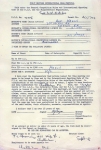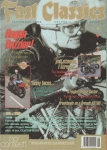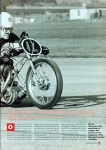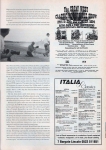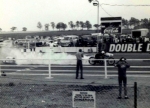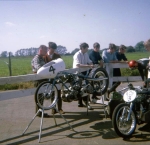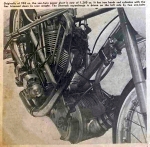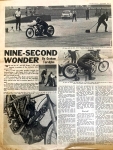|
Alf Hagon's story and history - Part 4 
As told exclusively to Part four of Alf’s story sees him continuing with sprinting and building his JAP powered machine for the Dragfests. He recalls the help given to him by Don Garlits and the American bike racers. He began to ride at the newly opened Santa Pod and began his domination of the strip where he held the track record for an incredible eight years. As the times continued to fall development of the bike continued to evolve and he became the first rider into the nines and the first to top 200mph. Thanks to Alf for the loan of items from his collection, many of which are shown below. With the Triumph I’d beaten George Brown and we went to Records day, and we broke the National 750 record. I sat down and thought with the drag racing it’s who wins the 125, 250, 350, it’s relevant. You’ve got to be the quickest, there’s no point buggering about with the others. I got a Vincent engine from someone, and my view of a Vincent engine is it’s like a block of concrete. The weight of it was ridiculous, and they had a way of making things more complicated than they needed to be. Then the JAP, they’d only made a few of them and Reggie Gilbert loaned me an engine. At the time it was a 1000cc limit. Len Cole said they’d had just arranged the 1964 Dragfest and the American team was coming over, so we built it with that in mind. The engine was 80 mm standard then there was an 84 mm bore x 99 stroke. I had a spare set of barrels and pistons with aluminium heads. We built that up with no supercharger. It vibrated pretty bad until we put that chrome stay on with a few modifications. With the vibrations fuel was coming out of the engine everywhere except going into the engine. The injectors were pretty useless. If you ran on petrol with a 200 jet then put in a 250 main jet it would run terribly. If you run Methanol with a 500 main jet and then put in a 1000 jet it will run more or less the same but will pump out fuel. Believe it or not the thing that cured the vibration was fitting the supercharger, I don’t know why and how that did it.
Alf’s approach to building the JAP showed a different set of priorities to the accepted wisdom of the contemporary riders of the day. He aimed to get maximum performance by using the lighter powerplant of the JAP V-twin, rather than opt for the popular, but heavy, Vincent engine, and giving it less work to do by making the bike as light as possible. With this in mind every spare ounce of superfluous weight was dispensed with during the initial build. He initially chose to run without a supercharger, and rear suspension and gearbox were deemed unnecessary, using instead the limited traction available to his advantage by spinning the rear wheel as the bike launched. A technique he was more than familiar with from the Speedway tracks. The 35lb frame contained no lower rails, bolting instead to the engine mounting plates. Items like pushrod tubes and rocker covers were dispensed with. The rear sprocket doubled as a disc brake, the oil was carried in the frame, the seat was merely a steel hoop with no pan. The cooling fins were shaved back to the barrels and there was hardly a washer to be found anywhere. The resulting power to weight ratio was second to none. In April 1964 Sydney and Alan Allard launched their “Dragon” slingshot at Silverstone. The supercharged 1500cc Ford powered car was designed to be sold in kit form as an easy way for people to get into Drag Racing. The cars designer John Hume recorded a 0-100mph time of 11.1 seconds and Alf and George Brown were at the launch to have a go themselves. Alf remembered the event well and commented that it was not an easy car to drive, and he much preferred riding his motorcycles. So we’re all 1000cc, the Americans are booked to come over and at the last minute they realize one of the Americans had a double engined Triumph, which of course is 1300cc. We immediately fitted the 84mm pistons. We went from 84mm pistons to Goldstar 86mm pistons and they just kept cracking. Then we went to 88mm Jawa Speedway pistons and the tops kept collapsing in. Then I got some Ford car pistons modified and fitted them. Don’t remember what happened to them. Then some G50 Matchless pistons and a 90 bore. So it was a 99 stroke 90 bore which was 1260cc. It was not running bad and we were at the Drag festival. I said to my mate, let's go and see Don Garlits. We asked him if he could give us any advice on our engine. He said “That’s a bit like a small block Chevy.” I’d read several books, and all the articles, and half are good and the others rubbish. One book on superchargers was a load of F— rubbish. With the carburettors we had, aluminium heads, I’d modified the Speedway cams and we had, with a supercharger, 8 to 1 compression and run anything up to 60% nitro. Looking back on it now I can see where we’d gone wrong. Anyway we went up to Don Garlits and he said “What ignition have you got?” I said “35 degrees.” He said “Stick it up to 45 degrees.” It made almost a second difference.
The different approaches to Drag Racing and Sprinting were becoming apparent at the 1964 Dragfest. Alf’s mantra was “the right machine for the job”, and he had built a bike specifically for a quarter mile race. In a match up with George Brown at Kemble he crossed the line first with a 10.85/123 to a 10.88/132. In Motor Sport magazine Denis Jenkinson wrote “To the initiated the terminal speeds in this match race were most enlightening, providing they were co-related to time, for they indicated that these two men had different ways of achieving the same e.t., Hagon having the advantage over the first half of the course and Brown over the second half. A technical study of these two motorcycles shows this to be so, for Hagon builds for ultra-light weight with just sufficient power, and Brown has more than enough power and can carry the weight imposition of supercharger, 4-speed gearbox, streamlining and rigidity. If the race had been over a ½ mile of a kilometre the Vincent would have won easily, but we are discussing the ¼ mile. Technically the Hagon machine is superior for the job of covering the ¼ mile, but by drag racing standards the brown machine is the best, as it gives a higher terminal speed.”
By the end of the series of meetings George Brown had run the best performance, a 10.30/146, but, armed with advice from Bill Wood and Don Hyland, the two visiting American bike racers, not to mention the knowledge acquired from Garlits, Alf continued to develop “the best machine for the job”. Incidentally Alf’s previous sprint bike, the Triumph “Mouse” was also racing at the Dragfests, now in the hands of Pete Smith. He won a trophy and £30 for the second best aggregate performance. Alf received a similar trophy and £20 for third. Then they were talking about the 9’s and we gradually got down. Then it wouldn't pull the single speed. It was like putting your car into top gear and trying pulling away. So we put a Norton gearbox in it, and blew a few of them apart. We made them into 2 speeds, second to top, and modified the clutch and extended it to an 8 plate clutch. It got a bit boring but we persevered with it.
Amongst Alf’s “perseverance’s” with the JAP over the next few years were a number of notable achievements and firsts. In May 1965 he broke George Brown’s long standing national record time of 10.29 with a 10.24. The race was on for a 9 second time slip! One month later at the NSA run meeting at the Debden Gala of Motorsport, it seemed that Alf had achieved this landmark feat. He recorded a 9.96/148 time, but while he was celebrating the achievement, the officials re-measured the course and found it was 26 yards too short!
At the October Woodvale round of the 1965 2nd Dragfest, Alf recorded the quickest time of all the bikes including the visiting Americans, 10.50. Two weeks later at the Elvington World Records Meeting, he broke 3 World Records; SS Quarter Mile 10.636, SS Kilo 19.135 and Kilo Flying Start 16.223 at an average speed of 221.903 kph.
At the October 1966 Elvington Records Weekend, Alf broke the World Record for the SS Kilo with a time one way of 19.306 and in the other direction of 18.964, giving a mean time of 19.135 seconds. He also broke the World Record for the Flying Kilo. His time for the west/east direction was 13.413, but on the return run, he could only manage 18.451 as a plug lead came off just into the run. Even so, his mean time of 15.932 seconds still took the record! At the 9th April 1967 NSA Duxford sprint, Alf entered two bikes. In the 500cc Class, his best time was 13.86, and in the 1300cc Class, it was 10.63. On the 9th July at the Duxford sprint organised by the Cambridge Centaur MCC, the 9 second barrier was finally broken. Three riders had been in contention to dip under ten seconds for the first time, George Brown and Ian Ashwell, both on 1000cc Vincent machines, and Alf on his 1200cc JAP bike. It was Alf who had the honour of breaking this barrier. On his first run, he recorded 10.10 but had problems slowing down with a flat front tyre. On his second run, he was oh so close with 10.03. It was on his third run that it happened with the time being 9.93 seconds.
At the Santa Pod 1st Motorcycle Drag Racing Championships held on 20th August 1967, Alf won the final of Top Eliminator in a time of 9.679/143.88, which at that time was the quickest ET in the world on two wheels. Back at Elvington in October for the Records meeting he put the SS Quarter Mile Record into the nines for the first time. On his first run his time was 10.05, on the return run it was 9.859 for an average of 9.9545 seconds. He is then reported to have put the bike up on its stands, climbed into his van and gone to sleep! Onto 1968 and at the SPR 21st April Season Opener, he made some demo runs on his JAP. His first run was a quickest ever 9.644/148.59 but with very little smoke from the slick. His second run was a much smokier but slower 9.718/144.09. In May, Alf became the first Englishman to go over 200 mph although it wasn’t at the end of a quarter mile run though. A 1/10th mile speed trap was set up on the 9000 foot runway at Honington Air Base in Suffolk. Obviously, the bike was fitted with a much higher gear ratio than normal which meant it required a tow start. The first run was at just three quarter throttle at 179 mph even though the rear tyre broke loose at 170. His second run at 189 mph also had problems as a pushrod dropped out. His third run at 180 mph resulted in the clutch expiring. It was on his fourth run that the target was reached even though the manifold let go in the speed trap. His speed was 206.54 mph. Alf made demo runs at SPR’s Big Go meeting the first weekend in June. His best time was 9.432/153.85 mph. A month later he was at Santa Pod for the Vagabonds Motorcycle Club Sprint Meeting. The only other rider at that time to have broken the ten second barrier, John Lloyd, was also present with his Vincent powered machine and the plan was to run a best of three match race. Amid much excitement both riders lined up for the first round only to both break their drive chains as they left the line. Lloyd quickly repaired his machine but suffered a gearbox failure on his next outing, putting him out of action for the rest of the day. Hagon however came back out and laid down his quickest ever performance, a 9.401 with a terminal speed of 155.76mph. Ian Ashwell then brought his Vincent out to challenge Hagon and managed a 10.174 but was no match for Alf who crossed the line with another new personal best of 9.208/154.8. (This was to be the quickest ever time for the bike).
The September SPR Motorcycle Drag Racing Championships meeting was eventually rained off but not before Alf had recorded 9.3/157.73. Magazine scans: click thumbnail to enlarge, click back to return. Gallery: click on any thumbnail for a large image.
Alf Hagon's story and history - Part 1 Alf Hagon's story and history - Part 2 Alf Hagon's story and history - Part 3 Back to pioneers index Back to News page |































